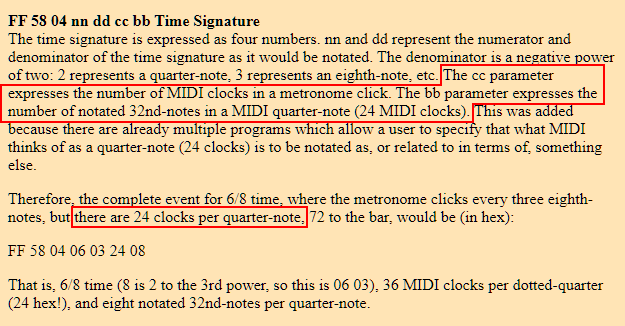2: First principles
The following definitions define events and ticks as they relate to human-machine communication. They are notation agnostic.2.1: event and tick definitions
An event is a temporal object symbolised, in music notation, by a duration symbol (a spatial object).In time, each event has an onset-time and a duration.
In space, each duration symbol has position, width and height.
In music notation, an event's onset-time is considered to be instantaneous. We are not concerned with the ramp in the envelope that can be observed using special apparatus.
An event may have no audible content: A rest is a duration symbol denoting a silent event.
An event may contain a single level of nested onset-times and durations (that have no duration symbols of their own). In this case, the event’s duration symbol can be decorated in some way (e.g. with an ornament such as
 etc.). Below that single level, onset-times are no longer perceived. Timbre is perceived instead.
etc.). Below that single level, onset-times are no longer perceived. Timbre is perceived instead.A tick is an imperceptible quantum of time.
Each tick has an instantaneous onset-time (tick.time) and an abstract duration (called a tick).
When using tick-based timing, all events begin and end on a tick grid. So:
Each event begins at an integral tick.time, and has a duration that is an integral number of ticks.
In all (ancient and modern) scores containing western polyphonic music (See e.g. Apel):
This means that:
Ticks carry both temporal and spatial information.
In particular, synchronous events at the beginning of a bar have the same tick.time, so:
Bars “add up” in (abstract) ticks.
The same is true for parallel voices in systems (that are as wide as the page allows) even when there are no barlines, so:
Systems also “add up” in (abstract) ticks.
Consider the following dimensional analysis:
If [tick] represents the dimension(s) of a tick, and [time] is the dimension of seconds, milliseconds etc., then a real time value (having dimension [time]) is created when multiplying ([tick] x ([time]/[tick])).
It can be seen that, whatever the dimension(s) of [tick] might be, they cancel out. Its therefore possible to treat ticks as dimensionless numbers, without ruling out the possibility that more inscrutable dimensions are involved.
Its important not to assume anything about ticks since we have no real knowledge of what goes on below the level of human consciousness. Time may just be the brain's way of coping with a more complex underlying reality.
2.2: “absolute” durations
Each event can be given an “absolute” duration (a duration in seconds, milliseconds etc.) by multiplying its abstract tick duration by a value that uses conventional temporal units.
Note that seconds, milliseconds etc. are not really “absolute”. They:
- depend on the use of external apparatus (clocks, metronomes, computers)
- are simply universally agreed units that enable inter-human, human-apparatus and inter-apparatus, communication.
- The ratio is not an integer, and that it can only change at a particular tick-position.
- The accuracy of the resulting “absolute” duration depends on the apparatus being used.
On the web: In Javascript, the function Number.toFixed(decimalPlaces) returns a number with a maximum of 20 decimal places, giving a theoretical accuracy of about (1 x 10-20) seconds, milliseconds etc. Conversion to MIDI 1.0's metric time ticks or MIDI 2.0 timestamps, that are both expressed in microseconds (1 x 10-6 seconds) should therefore be no problem. - A score that takes 100 hours to play would have (100 x 60 x 60 x 1000) = (36 x (10^7)) millisecond ticks.
On the web: That's well within Javascript's MAX_SAFE_INTEGER limit (which is greater than 9 x (10^15)).
The “absolute” duration of an event can be changed using any of the following methods:
- Change the ratio between tick duration and (milli)seconds.
Even if the ratio changes gradually over time (as in an accel. or rit.), this would not change the tick-positions of parallel events, so would not affect their relative alignments. - Change the event's tick duration.
Note that the following operations are independent of the ratio between ticks and absolute time, so real-time performance practice is unaffected.
-
Rubato in a single voice:
If the tick durations of other events in the same voice are changed accordingly, an event's tick duration can be changed without changing the voice's total tick duration. This operation can change the alignment of events in one voice with respect to events in other voices in the same bar. - Fermatas, rubato in parallel voices etc. (See also grace notes below):
If the same number of ticks is added, at the same tick.time, to all the voices in a bar, the bar's tick duration will change, but the relative alignments of the contained events will not.
- Different bars need not have the same tick duration, even when their duration symbols "add up" classically.
- A particular bar can contain duration symbols that do not "add up" classically.
(See §4.1: non-standard use of the Common Western event symbols below.)
-
Rubato in a single voice:
Tempo (crotchets per minute) is being replaced here by imperceptible milliseconds-per-tick values. Controlled changes to the absolute durations of events can therefore be made not only by adjusting their individual tick durations but also by warping the tick-grid.
Such adjustments are not possible using the late 19th century (Newtonian-Euclidean) time paradigm that associates fixed (mechanical) tick durations to the Common Western duration symbols.
Another way to look at this is to consider it as being a way to deal quantitavely with (the vaguely defined) 19th century “expressivity”.







.png)



